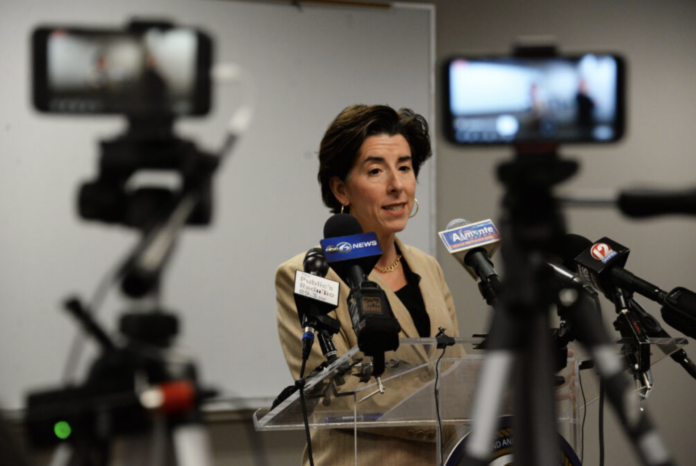
PROVIDENCE – Gov. Gina M. Raimondo said Wednesday Rhode Island is heading in the wrong direction for every metric in new coronavirus case trends.
“It is not a good news story,” said Raimondo during her weekly COVID-19 press conference. “I’ll say today, we’re in a bad place.”
“We need to turn the corner.”
According to Raimondo, based on the state’s current projections, it’s possible that Rhode Island could pass the surge capacity in hospitals in the next four to five weeks.
“We’ll have to start using our field hospitals,” said Raimondo.
Hospital surges would force Raimondo’s hand to roll back the state to Phase II of COVID-19 restrictions, she said Wednesday.
“We’ll all be asked to put our lives and businesses on hold,” said Raimondo.
The governor said she was not ready to announce any new restrictions, but will during a press conference on Oct. 30 at 1 p.m., and she said “anything is on the table,” from more regulations on workplaces to reducing the social gathering limit from 15 to a lower number.
Phase II ended months ago at the end of June when Raimondo introduced a scaled-back version of Phase III. The state continues to enforce Phase III guidelines, but issues around mask wearing and social gatherings have been two factors for rising case numbers, according to Raimondo.
“We are getting tired, we are getting fatigued and we are missing our friends and family,” said Raimondo, who encouraged Rhode Islanders to limit interactions to the people they have to see.
If Rhode Island were to return to Phase II, the effects could be devastating to some businesses.
Indoor recreational facilities such as bowling alleys, museums and movie theaters were all closed the last time the state was in the second phase. Retail stores and indoor dining at restaurants were allowed, but restricted to 50% capacity. Offices were encouraged to continue to allow their employees to work from home, but some could return at a 33% capacity if required.
R.I. Department of Health Director Dr. Nicole Alexander-Scott encouraged those in decision-making roles in workplaces to have employees work from home due to the recent spike in COVID-19 cases in workplace settings.
Cases in workplace settings have almost doubled in one week, from Oct. 13 to 19 from 48 cases to 88.
The majority of these cases come from manufacturing companies, according to Dr. Alexander-Scott, as well as retail and food service industries.
Gyms and fitness centers were able to begin a limited indoor reopening, but outdoor group fitness activities were preferred with a limit of one person per 150 square feet while observing social distancing practices. In classes such as yoga and spin, group sizes were limited to 15, not including staff, and whirlpools, communal saunas and steam rooms remained closed under Phase II, according to documents by R.I. Commerce Corp.
“If we can’t get a handle on the virus, business is going to be much more hurt,” Raimondo said in an interview with WJAR-TV NBC 10 on Tuesday night. “So, if we get to a place where our hospitals are overflowing or our death rate starts to really increase, it’s going to have a great impact on our economy. Unfortunately, there’s no free lunch and there’s no good option.”
According to the four reopening metrics that Raimondo previously outlined that would allow the state to move back a phase or move onto the next one, Rhode Island is already hitting one of the four metrics that would serve as an argument for the state to move back a phase.
Rhode Island’s current “R” value, or rate of spread, is approximately 1.3, according to Joseph Wendelken, the spokesperson for the R.I. Department of Health. To move onto the next phase of reopening, the R value, which determines how many people one infected person spreads the virus to, should be at 1.1 or less. If the R value is between 1.3 to 1.5, the state could consider moving back a phase.
When asked if this one metric would put Rhode Island at risk of moving back a phase, Wendelken said it would take more than the R value.
“Any decisions will be based on a number of factors, including new hospitalizations and hospital capacity,” said Wendelken. “There is not one metric we look at in isolation.”
New hospitalizations have been on the rise over the past month. According to the R.I. Department of Health’s COVID-19 Tracking page, there were 139 new hospital admissions over the last week, an increase from 103 one week prior, with a set threshold is 210.
Alexa Gagosz is a PBN staff writer. Contact her at Gagosz@PBN.com. You may also follow her on Twitter at @AlexaGagosz.
This story was updated to include figures on cases in workplace settings.










